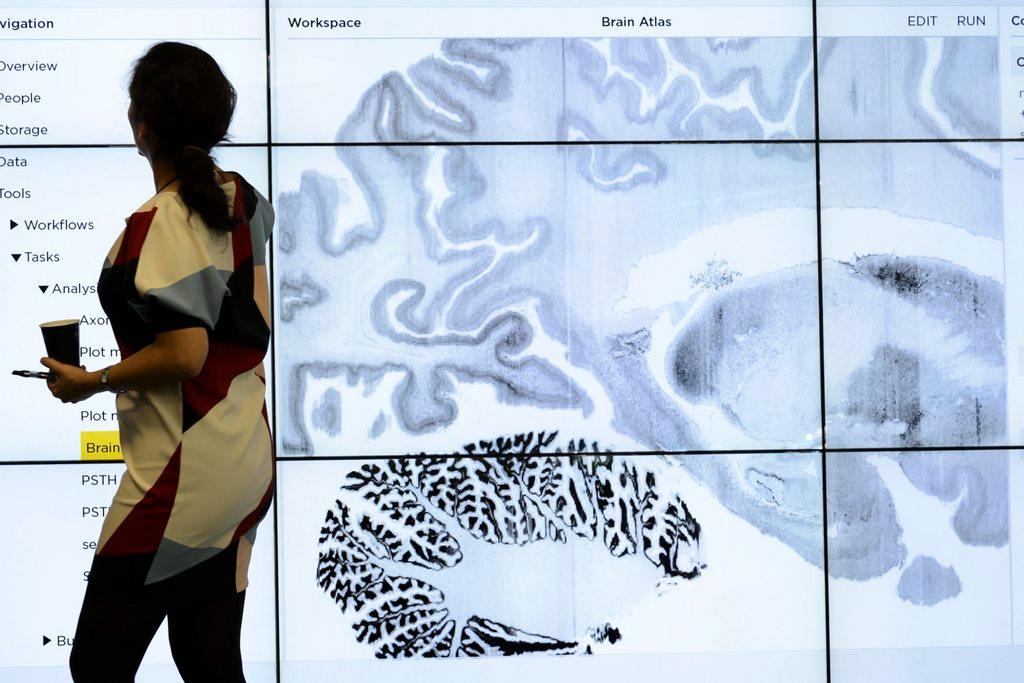Swiss non-profit aims to break taboo of women’s brain health

If depression is twice as common in womenExternal link than men worldwide, does that mean we need to change how we think about gender, health, and science? That’s the argument of the Women’s Brain Project, which is calling for a precision approach to brain disease research and treatment.
When scientists use animal models like mice in their experiments, standardisation is key: all animals must be kept in highly controlled conditions so that the study results are not compromised. But there is one very big difference that scientists might be ignoring: whether their subjects are male or femaleExternal link.
“Most labs today use only male or female mice, depending on the field. For example, people doing behavioural neuroscience experiments tend to prefer to work with male mice because there’s an assumption that they’re more stable and less variable than females due the oestrus cycle, which is incorrect. Either way, this is a mistake,” Maria Teresa Ferretti, a group leader at the University of Zurich Institute for Regenerative Medicine, tells swissinfo.ch.

More
Dementia cases on the rise
As Ferretti explains, the mouse problem is emblematic of the central challenge concerning the Swiss-based Women’s Brain ProjectExternal link (WBP), of which she is Chief Scientific Officer: how to characterise – and manage – gender differences in brain research and healthcare.
Founded in 2016, the WBP distinguishes itself from other women’s health projects with its focus on science, and advocates for a precision approach to brain disease research, treatment and prevention with respect to sex and gender. Its immediate goals include publishing reviews of the data on gender differences in brain diseases, and raising awareness of these differences at the research, medical, and policy levels. Ultimately, the consortium – which unites international experts in neuroscience, medicine, pharmacology, and psychology – hopes to establish a research institute in Switzerland.
For each of these goals, WBP has its work cut out for it – not least because the relationship between sex, gender, and brain disorders is extremely complex.
A different experience of disease
The WBP’s mission is rooted in evidence suggesting that men and women not only suffer from brain diseases and mental health disorders at different rates, but that there are also global sex and gender differences in how these maladies are experienced.
“Women are generally more affected than men by depression, almost two to one,” explains WBP Co-Founder Antonella Santuccione Chadha, who is also International Medical Manager for Alzheimer’s Disease for Roche Diagnostics Europe.
“Women also have a more chronic course of depressionExternal link and experience co-morbidities like anxiety, while men display more aggressive features and might be prone to alcohol abuse,” she says, adding that men also commit suicide more often than women.
According to Santuccione Chadha, sex and gender differences also persist in neurodegenerative diseases like dementiaExternal link, which affects more women worldwide, or Parkinson’s disease (PD), which disproportionately affects menExternal link.
“We’ve been conducting a scientific review of the available data, and it seems that of brain atrophy in the early stages of Alzheimer’s disease (AD) is also faster in womenExternal link,” Santuccione Chadha notes.
Watch Santuccione Chadha talk more about the differences for men and women in how they are both affected by and treated for brain diseases in this TEDx Carouge talk from February of this year.
Stress and stereotypes
But addressing all these variations, both at the level of scientific research and medical care, is more difficult than it might seem at first glance. Scientists simply don’t know to what degree these differences are down to genetics and biology – or sex – and how much is due to the social constructs and stereotypes that make up the experience of gender.
“In most cultures, women are seen as the main caregivers in the family. This can lead to more pressure or stress, which in turn can lead to health issues,” explains WBP Co-Founder and President Annemarie Schumacher Dimech, a study programme manager for palliative care at the University of Lucerne. She adds that such stress is especially pernicious for middle-aged women who find themselves simultaneously caring for children and aging parents, whom Schumacher Dimech refers to as, “the sandwich generation”.
Socioeconomic factors, which are often divided along gender lines, are also believed to play a roleExternal link in determining overall risk for AD.
“One of the risk factors for AD is low education and job attainment. Even in western societies like Switzerland, women tend to have lower education levels. And even if reach the same level as men, they tend to take jobs that are less challenging because they tend to stay with the family,” says Ferretti.
Of course, there are biological differences too. When it comes to mental health, hormonal changes in women can cause postpartum depression or other mood disorders related to premenstrual syndrome (PMS). Women also tend to have longer life expectancies than men, which could leave them more vulnerable to developing neurodegenerative diseases like AD later in life.
Rewriting science
The WBP says that while it is educating researchers and healthcare providers about these issues, awareness is only half the battle. “We need to rewrite the way we do science,” says Santuccione Chadha.
For example, there is no consensus on the best way to include both male and female mice in experiments. Is it better to divide the number of animals so that half are female, and half are male, or to double the number of study subjects? If the latter, is this ethical in terms of animal welfare?
Ferretti also argues that when it comes to pre-clinical research for drugs and therapiesExternal link, pooled data on human patients should be analysed to take gender into account – something that is not consistently done – but there are multiple statistical methods that could be used to do this, and no scientific agreement on the best way.
The WBP would also like to see change at the level of European research policy, in line with changes being made in other countries like the US. For example, NIHExternal link (National Institutes of Health) has recently created guidelines for submitting research grants that require candidates to describe how they are considering sex and gender factors in their research.
Breaking the taboo
But are there risks to looking at men’s and women’s brain health through individual lenses? Could research confirming differences in disease symptoms, diagnosis and prognosis be misused, for example to deny members of one gender access to certain opportunities or jobs, or to target them with higher insurance premiums?
Ferretti and her colleagues at the WBP acknowledge that when it comes to talking about gender differences and health, there is always the risk that information could be used prejudicially. But they maintain that this risk is smaller than that of ignoring such differences and their impact on health.
“What we are trying to say is that you might have small differences in basic physiological function, but when it comes to vulnerability to a pathology, those initial small differences might make a big difference later. I think we have to break the resistance to talking about these topics because people are afraid,” Ferretti says.
Santuccione Chadha adds that a precision approach to treating brain disorders based on a better characterisation of gender differences could even help lower health care costs.
“If you prescribe the right drug to the right patient population, it will be reimbursed accordingly, therefore the costs to the health system will be reduced. In oncology, there are already drugs that are approved for subtypes of tumours based on specific gene expression. It should also be possible to do this for mental and neurological disorders,” she argues.
One point the all three organisers stress is the project’s focus on equity.
“This is not a campaign just for women: by studying what’s going wrong in women’s health, we will also learn things that will help men. The final goal should be to help everyone to have the best possible prevention, diagnosis and treatment,” Ferretti summarises.
Another Swiss-based neuroscience initiative, the Human Brain ProjectExternal link, aims to model the human brain using the power of supercomputers to process the massive amount of data involved in simulating and connecting 100 billion neurons.
While there is not yet any collaboration between the two projects, the WBP has big data in its sights, and it will be a topic of discussion at their second International Forum on Women’s Brain and Mental Health at the University of Zurich in June 2019.
“Our idea for the future is to work with people on big data and algorithms, as we think that even in these huge datasets and in their analysis, there might be sex and gender differences worth exploring,” Ferretti says, referencing a 2016 JAMA articleExternal link that identified biases relating to mental and physical health in the functioning of Siri and other similar virtual assistant applications.
“We wonder whether there is a sex bias in these datasets that are used to generate predictive algorithms: If most of the data are collected from male populations, then you might have a model that only works for men.”

In compliance with the JTI standards
More: SWI swissinfo.ch certified by the Journalism Trust Initiative












You can find an overview of ongoing debates with our journalists here . Please join us!
If you want to start a conversation about a topic raised in this article or want to report factual errors, email us at english@swissinfo.ch.